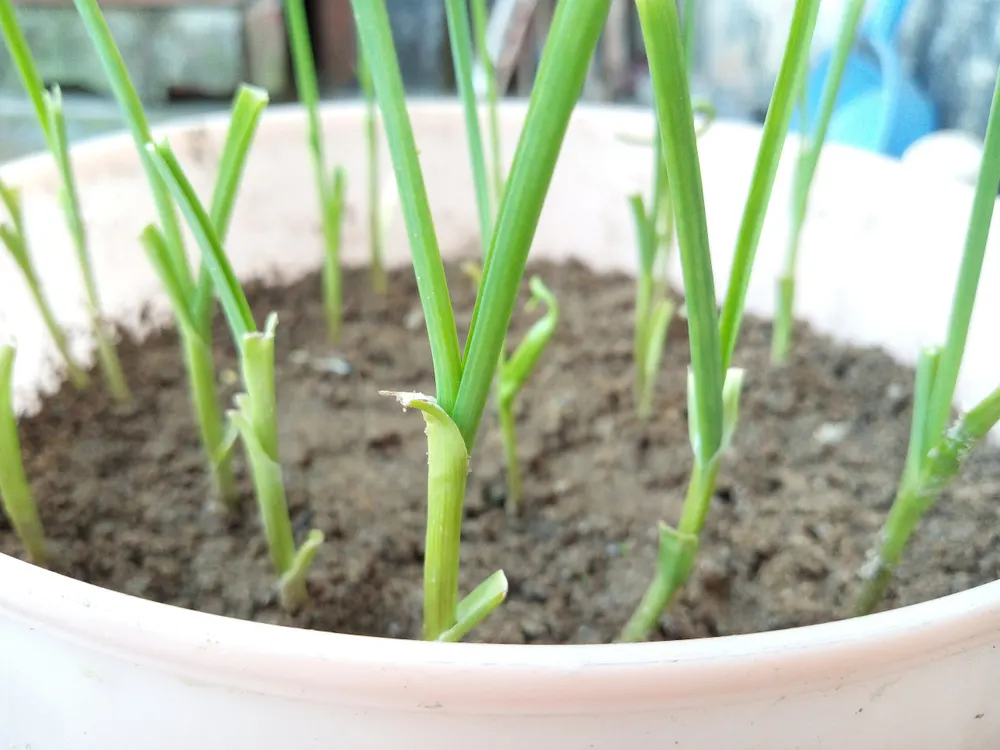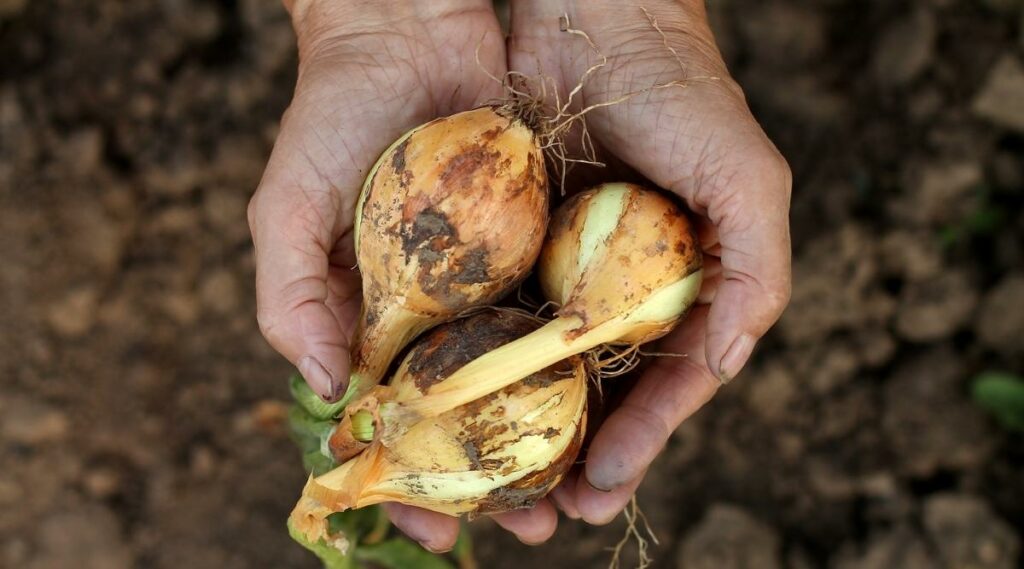Growing Onions in 5 Gallon Buckets – Complete Guide to Grow Onions in Bucket

Sandwiches, salads, soups, and other dishes can all benefit from the simple and extremely easy addition of onions. Also, there are numerous types of onions, including red, yellow, and white, and those with hot and sweet stems.
Of course, there are green onions, which give the meal flavor and color. For both rookie and seasoned gardeners, growing onions is enjoyable. Many people think homegrown onions in a 5-gallon bucket taste better than store-bought ones.
Some gardeners have asked me if they can grow onions in 5-gallon buckets.
If you’re wondering if you can grow onions in a 5-gallon bucket while living in an urban area, the answer is unquestionable yes. To make room for the bulb’s subsurface root system to expand. Likewise, provided the bucket is at least 10 inches deep, you may grow onions in 5 gallon buckets.
How many onions grow in a 5-gallon bucket?

Within each bulbous plant, there is only one bulb. The good news is that six to eight bulbous plants can fit in a five-gallon bucket. It gets even better by making the most of the available space in your bucket.
Some things need to be taken care of.
- Selection of container: The soil depth of bulb containers should be at least 10 inches. The diameter can be as large as it fits but remember that each bulb needs about 3 inches of space to grow in container gardening.
- A 5-gallon bucket is perfect for growing 6 or 8 bulbs.
- A large planter box or even a container works well.
- Make sure your tank has good drainage holes and try to raise it slightly off the ground.
The proper soil for onion in gardens
Container-grown onions do best in well-drained clay soil in pots with a slightly acidic to neutral pH. Before planting or growing, enrich the soil with plenty of mature compost and a balanced fertilizer to grow onions indoors.
 Proper watering
Proper watering
The onion needs about 1-2 cups of water per week. Be sure to check the soil because bulb plants often look healthy even though they need water. If using soil, the onion plant doesn’t need as much water. However, they should be checked regularly and watered, if necessary, especially during hot and dry periods. Review the dampness by sticking your finger into the soil from time to time. If you don’t feel moisture after that, it’s time to water.
Choosing a proper container
- Choosing the appropriate container can make a significant difference in growth. Like a root, an onion needs a lot of room to grow. But they don’t require as much space as people think. The actual onion you consume takes up most of the space.
- In addition, the root system is relatively shallow. At 10 inches depth, bulbs can grow as large as possible without worrying about overcrowding. Depth is the most important factor, so please get as wide a container as you want. Using regular 5-gallon buckets is an excellent choice for these homegrown plants.
- A standard hardware store 5-gallon bucket can grow 6-8 bulb plants. Plastic containers are light, durable, compact, and easy to carry with a handle. Take a few buckets and you can get a whole crop without taking up a lot of space. Other containers also work suitable for onion harvest.
- Onion family plants do well in pots, bed-like containers, or terracotta pots. You can even use hanging plants or simple containers so that onions grow well in a bucket. Just make sure it’s 10 inches deep and the pot will work just fine.

Before you start planting onions, you need to make some preparations.
- 5-gallon buckets are convenient but not suitable for container growing. So, it has to be rebuilt a bit. First, we need to make drainage holes. If you plant an onion directly in a bucket, water will collect at the bottom.
- This can create a fungal problem. Use the drill to make a hole in the bottom of the bucket. Make sure the auger you use is large enough to allow the water to seep in while keeping the soil contained.
- Place the drainage holes evenly around the perimeter of the pot. Also, some holes should be placed near the center. The goal here is to make sure there are no places for water to pool. We want all your tub bulbous plants to get the same amount of drainage capacity.
- Most 5-gallon plastic buckets have a reinforced rim. This is great for carrying heavy loads, but not so good for gardening. Place the bucket directly on the ground and this reinforced rim will prevent water from leaking.
- The easiest way is to use some pavers to grow onions. Arrange them so that they do not block the holes and you are ready to go. Many stores also sell risers that fit in 5-gallon buckets of onions.
Fertilization Methods for Onion Plants
- Despite the shallow root system, onions are heavy in nutrients. Plants use the nutrients in the soil as much as possible. Fertilization helps improve soil quality and promotes the rapid growth of plants.
- Onion needs all three major nutrients. These include nitrogen, potassium, and phosphorus. Plants take up moderate amounts of nitrogen. But they are higher in potassium and phosphorus. In general, standard nitrogen formulations work well. A 10-10-10 organic fertilizer works best.
- We recommend using nitrate-based formulas rather than sulfate-based formulas, as sulfates tend to make the resulting crop sharper. If you want sweet and tangy onion, you need to do this, use nitrate-based fertilizers. Side-feed the bulbs with a water-soluble fertilizer about three weeks after planting. Additional applications can then be applied every time in 2-3 weeks during the growing season. This step will help a lot to plant onion sets.

How to Harvest Onions?
- After treating the plants for about 90 days in a bucket, the bulbs are ready to be enjoyed in bucket. But you have to harvest them at the right time. Therefore, it is necessary to rely on the appearance of the culm.
- Onions are usually ready when the stems begin to dry and turn yellow. They will fall over, indicating the onion is ready. To harvest, simply pull out the vegetables with a stick. Shake the onion well to remove any dirt and set aside. Don’t cut the tip of onion sets yet! It takes about 7-10 days for the onions to harden.
- The aging process helps lock in and develop flavors. When you pull the vegetable out of the ground for the first time, you will notice that it has thin skin and thick flesh. Vegetables are very delicate at this point.
How much sunlight do onions need?

Bulbs still need plenty of sunlight while growing underground in buckets indoor. These plants need full sun every day. It is not a plant to put on a windowsill or in the shade. Place the pot on the south side of your home so the plant can enjoy the sun from dusk to dawn. To grow large, healthy onions, it is important to choose varieties suitable for the indoor region. There are 3 types of onions to choose from. The difference between these categories has to do with the amount of daily sun you need.
Short Day Onions
Long Day Bulbs
Long Day Bulbs are ideal for Northern gardens with long days. These strains require 14 hours of sunlight per day. Anything else and pears will not form properly. There are varieties of long-day onions such as Yellow Sweet Spanish and Ring Master. Chunichi Onions, these varieties are intermediate between long-day and short-day onions. Ideal for the Midwest and the Middle East, these bulbs require 12-14 hours of sunlight per day for bulb formation.
What are good companion plants for growing onions?
Onions are a popular vegetable crop that can benefit from growing companion planting. Growing some good companion plants can help repel pests or attract beneficial insects, while others can improve soil health and nutrient availability. One good companion plant for growing onions is garlic, which can help deter onion flies and other pests that feed on alliums.
Another helpful companion is chamomile, which can attract hoverflies that prey on aphids and other harmful insects. Additionally, growing beans or peas near onions can improve soil fertility by fixing nitrogen.
Marigolds can also be useful as they have been known to repel nematodes, which can damage onion roots. Overall, planting a variety of companion plants alongside onions can help support their growth and health, while also creating a diverse and thriving garden ecosystem.
Are carrots and potatoes good companion to plant onion sets?
Indeed, onions and potatoes make good gardening partners for planting onions.
Because their roots are at various depths, onions and carrots complement one another well. Carrots have longer roots than onions, which have shallower roots. As a result, they won’t have to compete with one another for the same soil nutrients as they develop together.
Also, a wonderful companion plant for onions is potatoes. By generating a smell that is repulsive to these pests, they can assist in warding off insects that can attack onions, such as onion flies. Furthermore, because potatoes require different nutrients than onions, they can assist maintain a balance in the soil’s nutrient levels.
Conclusion
In a 5-gallon bucket, grow onions at home in an affordable and efficient manner. Maintaining proper soil drainage, providing enough sunlight, and watering frequently are the keys to growing onions successfully in a bucket. With the right care and attention, onions may be grown in a 5-gallon bucket and will produce a sizable crop. Whether you have a small balcony or a large backyard, growing onions in a bucket is an excellent way to enjoy fresh, home-grown vegetables. Why not start growing onions and observe the consequences for yourself?
